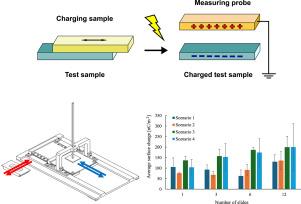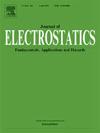A measurement method for testing textile materials charging for self-charging electrostatic face masks application
IF 2.1
4区 工程技术
Q3 ENGINEERING, ELECTRICAL & ELECTRONIC
引用次数: 0
Abstract
Electrostatic masks are significantly more effective than conventional mechanical masks due to their enhanced filtration efficiency. The charge of filtering textiles is generated by friction between two layers due to the spontaneous movement of the mask under wearing. However, the filtrating efficiency is diminished over time as the electrostatic charge decays, especially in humid environments. An essential requirement would be to compare the filling properties of various textiles used for masks by reliable measurement to produce more effective masks. However, no standardized procedure exists for measuring the charge of textiles. In this paper, a new test arrangement and protocol were developed to measure textiles’ charging due to friction accurately is presented. The new test system is built up from a stationary sample holder and a movable element holding another sample to simulate friction between the layers and ensure the measurement repeatability. The surface charge of tested textiles was measured using a parallel plane electrode system positioned 0.5 cm above the textile, connected to a high-impedance voltmeter. The tested textiles’ initial charging can be determined by measuring the voltage of plane electrode. The results demonstrate that the newly developed test setup enables testing the charging capabilities of various mask filters and ensuring the comparability of various textile materials.

用于自充电静电口罩的纺织材料充电的测试方法
静电口罩比传统的机械口罩更有效,因为它们的过滤效率更高。过滤织物的电荷是由两层之间的摩擦产生的,这是由于口罩在佩戴时的自发运动。然而,随着时间的推移,随着静电荷的衰减,过滤效率会降低,特别是在潮湿的环境中。一项基本要求是通过可靠的测量来比较用于口罩的各种纺织品的填充特性,以生产更有效的口罩。然而,现时并无量度纺织品收费的标准程序。本文提出了一种新的测试方法和方案,可以准确地测量纺织品的摩擦电荷。新的测试系统由一个固定的样品夹和一个可移动的元件组成,以模拟层之间的摩擦,并确保测量的可重复性。测试纺织品的表面电荷是用一个平行的平面电极系统测量的,该系统位于纺织品上方0.5厘米处,连接到一个高阻抗伏特计。通过测量平面电极的电压,可以确定被测纺织品的初始充电情况。结果表明,新开发的测试装置能够测试各种口罩过滤器的充电能力,并确保各种纺织材料的可比性。
本文章由计算机程序翻译,如有差异,请以英文原文为准。
求助全文
约1分钟内获得全文
求助全文
来源期刊

Journal of Electrostatics
工程技术-工程:电子与电气
CiteScore
4.00
自引率
11.10%
发文量
81
审稿时长
49 days
期刊介绍:
The Journal of Electrostatics is the leading forum for publishing research findings that advance knowledge in the field of electrostatics. We invite submissions in the following areas:
Electrostatic charge separation processes.
Electrostatic manipulation of particles, droplets, and biological cells.
Electrostatically driven or controlled fluid flow.
Electrostatics in the gas phase.
 求助内容:
求助内容: 应助结果提醒方式:
应助结果提醒方式:


